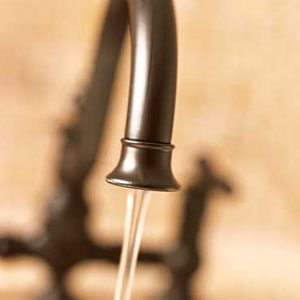25 Years of Innovation: Faucets
Today, there's as much variety in fixtures as in any other
element of home decor.

Photo: William A. Boyd
In the old days, choosing a faucet was a no-brainer: You
said okay to whichever fixture your plumber provided. There were kitchen and
bath showrooms, sure, but manufacturers hadn't started courting homeowners
directly. Today, educated consumers, empowered by the Internet, well-stocked
home centers, and, if we may be so bold, shows and magazines like This Old
House, are steeped in the latest trends. For a look at what's hot now—and
what's coming—turn the page.
The Past
A typical '70s kitchen had a chrome-finished faucet with acrylic hot and cold knobs. Single-lever controls were just beginning to catch on, and if you were truly cutting-edge, you had a separate side sprayer—"to wash the baby with," as our bemused host suggested during This Old House's first season, in 1979.
The Past
A typical '70s kitchen had a chrome-finished faucet with acrylic hot and cold knobs. Single-lever controls were just beginning to catch on, and if you were truly cutting-edge, you had a separate side sprayer—"to wash the baby with," as our bemused host suggested during This Old House's first season, in 1979.
The Present
Convenience, style, and functionality are the watchwords of today's kitchen and bath faucets. European manufacturers started a trend in the 1980s when they began treating faucets as an integral part of interior design. Today, there's as much variety in fixtures as in any other element of home decor.
Convenience, style, and functionality are the watchwords of today's kitchen and bath faucets. European manufacturers started a trend in the 1980s when they began treating faucets as an integral part of interior design. Today, there's as much variety in fixtures as in any other element of home decor.
The Future
According to the MIT Media Lab, where inventors are busy brainstorming new kitchen technologies, faucets of the future will have more bells and whistles—and lights. LED lights hidden inside the faucet will turn the water from red to blue depending on the temperature. Here are some other faucet innovations we might see, based on MIT and industry sources.
According to the MIT Media Lab, where inventors are busy brainstorming new kitchen technologies, faucets of the future will have more bells and whistles—and lights. LED lights hidden inside the faucet will turn the water from red to blue depending on the temperature. Here are some other faucet innovations we might see, based on MIT and industry sources.
- Tiny cameras in the faucet will recognize what's under the spout and adjust the water temperature accordingly: cold for veggies, warm for hands, hot for pots, and so on.
- As water conservation efforts increase, electronic faucets will enter the mainstream, with voice commands ("the faucet is running") and built-in meters that monitor consumption.
- Antimicrobial coatings in the supply lines will help defend against waterborne bacteria.
- Installation will continue to get easier, with modular fixtures that snap into the faucet deck.
Innovations
Their looks grab lots of attention, but today's faucets also perform better, last longer, and are easier to install than previous models.
No-Drip Mechanics
Faucets used to work with compression valves — up to a point anyway. Eventually, the rubber washers that control the flow of water would erode, resulting in a slow, steady drip. Not so with today's ceramic disc technology. Disc valves, which shear open and shut, remain virtually leak free.
Finishes That Last
For years, chrome plating was king because of its durability (think car bumpers). Other finishes required clear coatings that would eventually chip, leading to corrosion of the base metal. But thanks to a high-tech bonding process called physical vapor deposition, or PVD, any finish, from brushed nickel to rubbed bronze, can last forever. The technology was adopted from the tool industry, where it's used to give drill bits their impervious finish.
No-Sweat Installation
Old copper tubing was inflexible and needed soldering at the joints. Today's fixtures have flexible supply lines with push-and-click connectors, so homeowners can make their own hookups with only a wrench and a free Saturday morning.
Source: This Old House Magazine
by Dan Diclerico
Http://www.guaranteedplumbingco.com

No comments:
Post a Comment